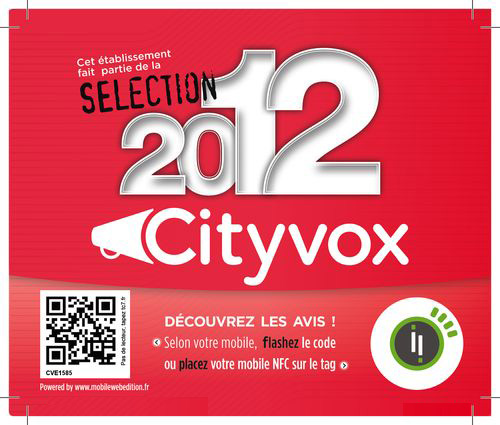French media content company Cityvox—a subsidiary of France Telecom Group—has begun enabling diners to employ radio frequency identification technology to view reviews and ratings at more than 1,500 restaurants throughout the nation. The system, provided by sister company Orange, consists of Near Field Communication (NFC) passive RFID stickers attached at restaurant entrances, as well as software that directs a consumer’s NFC-enabled mobile phone to a Web site listing content for that specific restaurant, based on the sticker’s ID number. Each sticker also comes with a QR code printed on the front, with the Cityvox logo, that consumers can utilize to access that same information in the event that their phones are not equipped with NFC RFID readers.
In addition, the solution includes NFC-enabled guest receipt folders that waiters and waitresses can provide to patrons at the end of their meal, when the time comes to pay their check, explains Laurent Michel, Orange’s director of innovative projects. The folders have a built-in NFC tag that users can read via their phone, in order to access a Web site at which they can then post reviews of their own meals without leaving the table.
Cityvox operates a network of Web sites offering local content throughout France, that feature ratings for the most popular restaurants, as well as reviews posted by the public. This year, the firm opted to try using NFC technology to make it easier for the public to access that information. The company approached Orange for a solution, which it first trialed in Paris for several weeks before proceeding to mail 1,553 “Cityvox Selection” stickers this month to restaurants within 133 French cities earlier this month.
Upon receiving a sticker, which contains an RFID inlay made with a NXP Semiconductors NTag203 chip, the restaurant affixes it to a window or doorway in front of its business. However, Michel notes, the sticker must be attached outside the window, since it can not be read well through glass. The URL encoded to the sticker’s RFID chip then directs the mobile phone to a server designated for that specific restaurant’s reviews and ratings.
When an individual arrives at the restaurant, that patron can tap his or her phone against the tag. The phone then reads that tag, but does not require a downloaded application to do so; instead, the phone simply captures the URL to access the server corresponding to that address. The user can then view and scroll through the published reviews.
After finishing a meal, a customer may receive the receipt in a folder containing another NFC tag. In this case, that person taps the phone against the tag to automatically access a server for posting reviews regarding that establishment. The visitor can then simply type in his or her comments, and also select a number of stars to rate the business. The reviews are presented on Cityvox’s Web site for others to view, either from a PC or a phone, and the company collects the ratings in order to determine which restaurant within a particular local area is most popular, and thus deserves “Selected” status.
The tags were sent to restaurants that pay for a Cityvox membership. The eateries were not charged for the tag placed at the entrance, though restaurants do pay for the receipt folder, as well as any additional folders. For example, they could order a sufficient number of tags for each table.
The stickers have been deployed for several weeks, Michel reports. The business owners initially “seem interested” in the concept, he says, though he does not know how many of the stickers have actually been placed at entrances to date. “This is a great, interactive way to get and to share reviews,” he says. For restaurants, he adds, the technology can draw more customers into their establishment, based on the favorable reviews they read on their phones.
Orange designed the tags to be sturdy enough to resist rain, and expects them to last for at least a year before replacement becomes necessary. Michel says he visited some of the Paris restaurants that trialed the system for several weeks this fall, and that the owners were pleased with the results. However, he cautions, it is too early determine the extent to which the technology may be increasing traffic into those establishments.
Restaurants are already familiar with Cityvox’s “Selected” stickers, Michel says, because the company traditionally sends such stickers (without NFC tags) to those that earn such recognition, as a form of promotion.
For Cityvox, the NFC-based solution’s benefits come not only from sales of the receipt folders, but also from publicity generated by the new technology.



